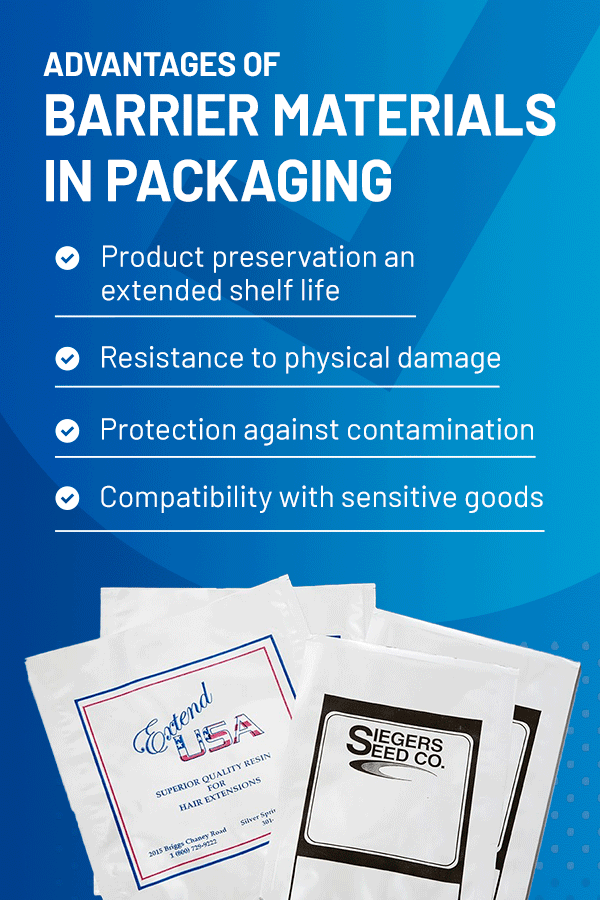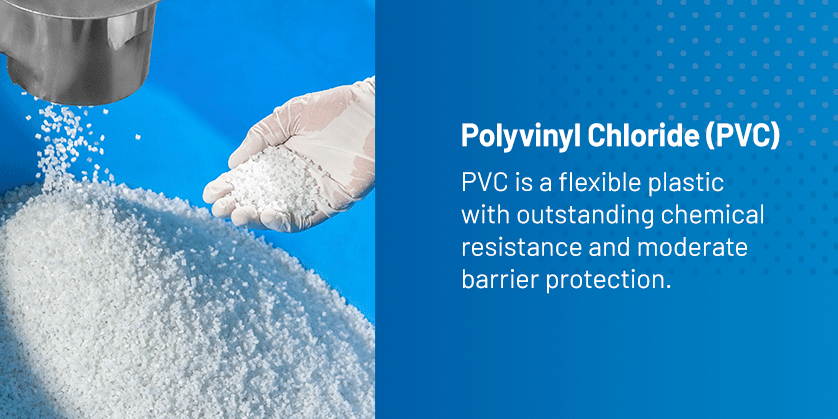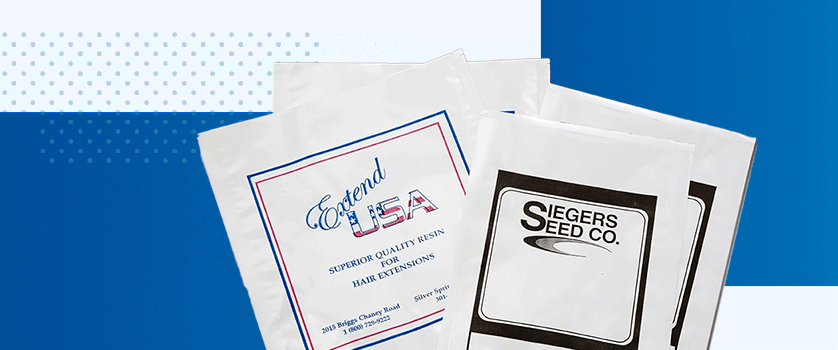Barrier packaging is a specialized form of protective casing that shields sensitive products from damaging external elements such as oxygen, moisture, light, pathogens and volatile organic compounds. By creating a physical barrier between the product and environmental contaminants, this type of packaging helps preserve product quality, extend shelf life and maintain freshness during transport and storage. It is widely used in industries that cannot risk contamination, spoilage or degradation, including food production, pharmaceuticals, electronics and industrial manufacturing.
This article explores the advantages of barrier packaging, how barrier effectiveness is measured and which protective barrier materials offer the right level of performance for different applications. Whether you are seeking flexible barrier bag packaging for small-batch shipments or large-scale barrier bags for packaging bulk goods, understanding the science behind these materials will help you select the best solution for your operation.

Advantages of Barrier Materials in Packaging
The primary purpose of barrier packaging is to keep products safe from environmental exposure. When chosen correctly, protective barrier materials deliver benefits that go beyond containment:
- Product preservation and extended shelf life: By blocking moisture, oxygen and light, barrier packaging prevents microbial growth, oxidation and aroma loss. These packages keep consumable products such as coffee, dried fruits and pharmaceuticals fresh, flavorful and visually appealing for longer.
- Resistance to physical damage: Beyond chemical interactions, barrier films guard against physical damage such as punctures, tears and compression during handling and transit. Some laminated barrier bags use reinforced layers or metallized films to bolster structural resistance while maintaining flexibility.
- Protection against contamination: Barrier films safeguard against environmental pollutants, dust and microbes, which is vital for food and beverages, medical devices and electronic components.
- Compatibility with sensitive goods: Industrial components and defense-related shipments often require anticorrosive, electrostatic-safe environments. Some barrier packaging films include volatile corrosion inhibitors (VCIs), antistatic coatings or multilayered polymers that offer both shielding and mechanical protection.
- Support for regulatory compliance: Sensitive industries such as aerospace and military demand packaging materials that comply with federal codes like MIL-STD-2073. Spec-grade barrier bag packaging ensures that shipped items meet environmental performance and traceability standards.
How Is Barrier Measured in Packaging?
The performance of barrier packaging is determined by how effectively it restricts the flow of gases and moisture. Barrier effectiveness is quantified through standardized tests that measure a material’s permeability over a set period. The lower the transmission rate, the stronger the protective properties. Two of the most widely used metrics are:
1. Moisture Vapor Transmission Rate (MVTR)
MVTR measures the rate at which water vapor passes through a material over time. It is typically expressed in grams per 100 square inches per day (g/100 in²/day) or grams per square meter per day (g/m²/day).
Low MVTR values indicate strong resistance to moisture ingress, which is crucial for products like semiconductors, medical instruments and powdered substances that degrade in humid environments. Packaging films with integrated aluminum foil or polyvinyl chloride laminates offer superior moisture barriers.
2. Oxygen Transmission Rate (OTR)
OTR quantifies how much oxygen gas passes through a packaging material in a defined period. This metric is usually expressed as cubic centimeters per square meter per day (cc/m²/day) or cubic centimeters per 100 square inches per day in U.S. units.
OTR is critical in determining whether a material can protect oxygen-sensitive goods such as pharmaceuticals, oxidizing chemicals or food products susceptible to rancidity. Films made with ethylene vinyl alcohol (EVOH) or metallized polymers generally exhibit excellent OTR resistance, making them ideal for applications that require long-term freshness or corrosion control.
Barrier Materials in Packaging
Barrier performance depends heavily on the composition of the material. Each material type has distinct properties that suit different industries, product categories and environmental conditions. By combining or layering these substances, manufacturers can fine-tune barrier packaging to achieve the required level of protection.
Below are the most common protective barrier materials used in commercial and industrial applications:
1. Ethylene Vinyl Alcohol (EVOH)
EVOH offers exceptional protection against gases like oxygen, nitrogen and carbon dioxide, making it especially useful for food, pharmaceuticals and medical packaging. EVOH films are often coextruded with polyethylene (PE) or polypropylene (PP) to optimize strength, flexibility and moisture resistance.
2. Nylon (Polyamide)
Nylon is known for its toughness and puncture resistance. This material performs well in flexible packaging where abrasion or impact could be a concern, such as in packaging sharp-edged industrial parts or heavy hardware.
In addition to its physical strength, nylon offers a moderate oxygen barrier, which can help slow oxidation in packaged foods and protect moisture-sensitive products. It is frequently layered with other polymers to enhance protective qualities.
3. Polyethylene (PE)
PE is one of the most common materials used in barrier packaging due to its flexibility, lightweight nature, moderate moisture resistance and heat-sealing properties. High-density PE provides additional stiffness and chemical resistance, while low-density PE offers softness and clarity for applications where product visibility is essential.
PE is suitable for packaging fresh produce, meat, bakery products and frozen foods. It is also ideal for encasing medical devices and electronics when paired with a secondary gas barrier.
4. Polypropylene (PP)
PP delivers moderate moisture and oxygen resistance and excellent tensile strength. It’s more rigid than PE and offers superior clarity. Oriented PP (OPP) and biaxially oriented PP (BOPP) are often used for their printability, transparency, sealing capabilities and grease resistance, making them ideal for snack packaging, industrial kits and resealable barrier pouches.
5. Polyethylene Terephthalate (PET)
PET is a clear, lightweight yet strong material that performs well as both a structural and barrier layer. It provides reliable resistance to gases and moisture, making it highly versatile across multiple sectors.
PET also offers good printability, making it a popular choice for consumer-facing products that require attractive, branded packaging. It’s commonly used to make water bottles, microwavable trays, thermoformed containers, pouches and flexible laminated films.

6. Polyvinyl Chloride (PVC)
PVC is a flexible plastic with outstanding chemical resistance and moderate barrier protection. It is transparent and easy to shape, but degrades when exposed to UV radiation unless treated.
Because of these properties, PVC is most often used in applications where clarity and affordability matter more than long-term resistance. It is ideal for office supplies, electronic packaging, protective sleeves for nonfood items and products that need rigid or semirigid packaging.
7. Polyvinylidene Chloride (PVDC)
PVDC is a highly effective oxygen and moisture barrier. It has a glossy finish and is often used to coat other substrates, such as PET, to improve overall barrier performance. It’s especially useful when transparency and high protection are both required, such as in seasoning packets, sausage casings, cheese wraps and pharmaceutical packaging.
8. Metallized Films
Metallized polyester films are produced by coating a thin polymer base, such as PET, with a vapor-deposited layer of aluminum. This process combines the flexibility of plastic with the impermeability of metal.
Metallized films like Mylar® and vacuum metallized PET (VMPET) offer excellent barriers against oxygen, moisture and light, making them a popular alternative to foil. They are suitable for products that are highly sensitive to oxygen exposure, such as coffee beans, dry spices and nutraceutical powders.
9. Aluminum Foil
Aluminum is considered one of the most effective protective barrier materials. It is impermeable to light, gases and moisture, providing nearly complete protection. Aluminum is often laminated with polymers or paper to improve its flexibility and usability. It is used in beverage cans, pharmaceutical products, military-grade packaging and high-barrier laminates for food and industrial goods.
10. Glass
While not used in flexible barrier packaging, glass is still considered a gold standard for impermeability. It completely blocks moisture and oxygen, and laminated or specialized glasses can also block UV light. However, its fragility, weight and cost limit its applicability to rigid packaging formats like jars and vials.
Levels of Barrier Protection in Packaging
Most barrier packaging solutions fall into four performance categories — basic single-layer, basic double-layer, moderate and high-performing. Each level is defined by how effectively the material restricts the passage of oxygen, moisture, light and other contaminants quantified through MVTR and OTR tests.
Understanding these levels helps you choose packaging that balances cost with the protection your products need:
1. Basic Single-Layer Barrier
Basic single-layer barriers provide foundational protection for products that are less sensitive to oxygen or moisture. Examples include single layers of polyethylene and polypropylene films used for general-purpose bags and wraps.
These films reduce surface contact with air or humidity for a short period but lack the structural or chemical properties to block oxygen, light or vapor in high-humidity or long-storage applications. They are widely available and cost-effective.
2. Basic Double-Layer Barrier
Basic double-layer structures combine two materials, often through lamination, to create a stronger moisture and gas barrier. A common combination is PET/PE or PP/PE, which provides better protection than a single layer.
They also provide better mechanical strength, making them less prone to punctures and tears. Double-layer barrier bags for packaging are widely used for heavier products like rice, grains, pet treats and dry snacks.
3. Moderate Barrier
Moderate-level protective barrier materials enhance oxygen, aroma and moisture resistance and can include coatings that help filter UV light. PET and PVC are commonly used here, often laminated with other plastics or metallized layers. This level of protection helps maintain the freshness of products like confections, powdered supplements, meats and cheeses, industrial components and certain electronics.

4. High-Performing Barrier
High-performing barriers represent the most advanced form of barrier bag packaging. These multilayered barriers integrate materials such as EVOH, PVDC, aluminum foil and metallized films like Mylar® or VMPET laminated onto base materials to provide near-total protection from moisture, gases, odors, UV rays and visible light.
This level of packaging locks in freshness and significantly extends shelf life, making it a preferred choice for high-value or mission-critical items. It is common in military, aerospace, pharmaceutical and industrial supply chains, especially where moisture, oxidation and light exposure pose a direct risk to product performance, safety or regulatory status.
Choosing the Right Barrier Packaging for Your Application
Selecting the proper barrier packaging is a strategic decision that requires balancing performance, cost and industry standards. The wrong choice can lead to losses, product failure, wasted inventory and even medical emergencies for the end consumer. Consider the following factors to avoid under- or overpackaging:
1. Evaluate Product Sensitivity
The first step is understanding what your product is most vulnerable to. Items like semiconductors, pharmaceuticals or specialty chemicals often require very low oxygen and moisture exposure. Food products rich in oils, such as nuts, coffee or spices, require extremely low oxygen transmission rates to prevent rancidity and preserve flavor. By contrast, fast-moving consumer goods may only need basic moisture protection, while industrial products like fasteners may only need protection against humidity.
2. Consider Storage and Transit Conditions
Determine whether the goods will be stored in climate-controlled facilities or exposed to fluctuating humidity, heat or UV light during transit. Hot, humid climates demand packaging with low moisture vapor transmission rates, while goods exposed to outdoor storage or direct sunlight require higher barrier ratings for UV resistance.
3. Define Shelf Life Requirements
Another key factor is the desired shelf life. Products intended for immediate consumption or short-term distribution are often well-served by basic single- or double-layer films. However, goods that move through complex global supply chains, sometimes sitting in warehouses or undergoing long overseas transit, benefit from moderate to high-performing barriers that preserve quality over extended periods.
4. Align With Industry and Regulatory Standards
In many sectors, regulatory and industry standards guide packaging decisions. Military and defense applications require strict compliance with specifications for barrier bags for packaging, while the food and pharmaceutical industries must meet FDA and international safety requirements. Choosing materials that meet these standards helps companies maintain compliance while protecting valuable goods.
5. Balance Performance With Cost
Each additional layer or barrier coating adds material cost. The goal is to select a barrier that meets performance requirements without overengineering. For example, a double-layer PET/PE laminate may suffice for dry grains, whereas a foil laminate is more appropriate for oxygen-sensitive pharmaceuticals or mission-critical electronics.
6. Factor in Convenience and End Use
Consider whether your packaging needs resealable zippers, tear notches or custom label printing for inventory management. Configuring barrier bags with features that improve usability without compromising protection can give you a competitive edge in the market.
Get High-Performance Barrier Packaging From Edco Supply Corporation
Barrier packaging is critical for protecting products from oxygen, moisture, light and other external elements across industries. The right materials extend shelf life, preserve quality and safeguard sensitive goods from environmental stress during storage and transit. Whether the challenge is moisture intrusion in electronics or compliance with strict military standards, effective solutions provide the stability businesses depend on to operate confidently.
Since 1954, Edco Supply Corporation has provided reliable solutions in military specification packaging and commercial barrier bag packaging. With one of the largest inventories of protective barrier materials in the United States, we deliver stock and custom barrier bags that meet the highest performance and compliance standards.
Whether you need aluminum foil laminate bags for moisture-sensitive parts, static-shielding films for electronics or resealable pouches for industrial materials, Edco can manufacture and ship to meet your deadline regardless of your project’s size. Our deep inventory, competitive pricing, fast lead times and flexible production allow us to support everything from short runs to complex, high-volume jobs.
Contact Edco today to request a quote or discuss your requirements. A knowledgeable team member will help you select the right material and format based on your operational and regulatory needs.




